
Iris classification
Classification of naturally occurring iris
To understand the diversity of species, forms or varieties of any plant group it is necessary to know the basis of their classification. Cultivated plants do not exist by themselves, but originate from wild ones. Wild, or natural species and cultivated plants are connected forever. It is well known from the practice of plant-growing that any time the danger of extinction for some reason meets a cultivated plant, man looks for its wild relatives to hybridize them and thus bring the vanishing species back to life. It is necessary, therefore, to start our acquaintance with the iris classification from wild species of the genus Iris.
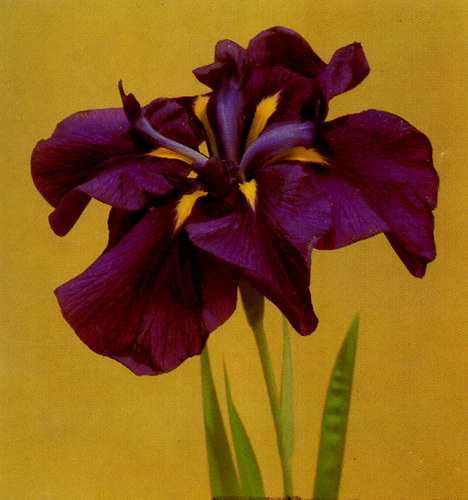
8. Japanese iris 'Yurij Gagarin'
A genus in botany is no more convention. It involves only the species whose close relationships are evident and show their origin from a common ancestor.
Sometimes it is rather difficult to determine a true degree of relationship between species, and errors are possible.
Over a long time, the opinion was predominant among botanists that the structure of the flower is the most reliable feature for determining relationship.
One of the authors of this book (G. I. Rodionenko) worked out a new botanical classification of iris, published in 1961, as the result of long-term studies of numerous species of iris and allied genera with an application of data from anatomy and genetics, as well as on their geographic distribution and specificity of their ontogenesis and with consideration of advantages and disadvantages of the previous classifications.
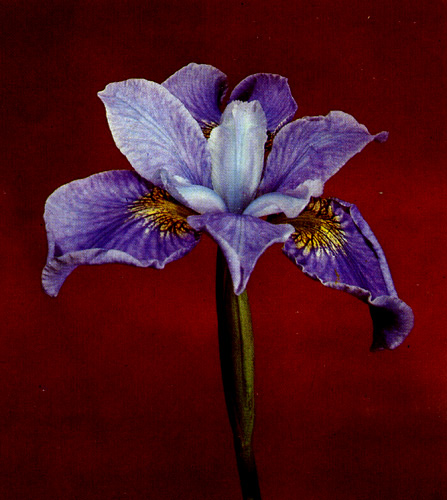
9. Siberian iris 'Cambridge'
According to the new system, bulbous and bulbotuberous species do not pertain to the genus Iris, and the remaining rhizomatous are distributed between the subgenera Limniris, Xyridion, Crossiris, Iris, Nepalensis and Pardantopsis. Nowadays, the genus has grown still narrower, since W. Schultz, a botanist from the GDR (1969), and L. Lentz, an American botanist (1972), proved in their works that the subgenera Nepalensis and Pardantopsis have no close relations with the iris.
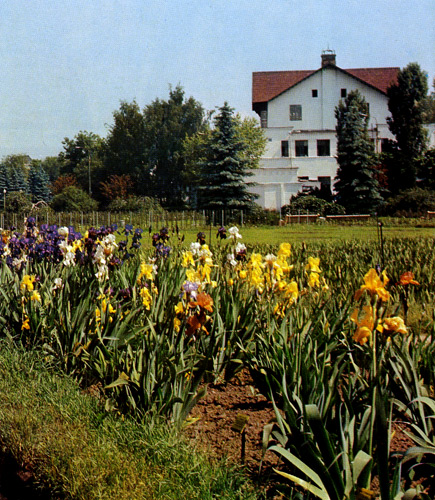
10. Irises at the Exhibition of the National Economic Achievements, Moscow
The subgenus Limniris, that has especially many species, is native to North America, Asia, Europe and the Mediterranean coast of North Africa. Among 58 iris species of the flora of the USSR 14 are pertaining to this subgenus. A feature common to all these species is the absence of a "beard", that dense hairy strip on the standards and falls. They are known as beardless iris in floricultural literature. The main species group of the subgenus Limniris has retained the same name in the new genus Iris classification.
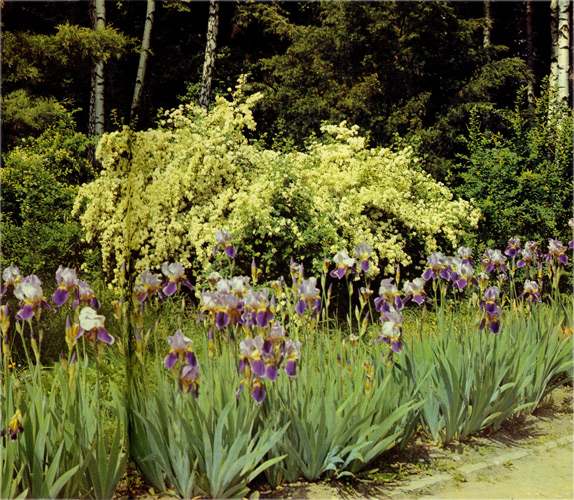
11. Irises and spiraea
From an ecological point of view, the subgenus is not homogeneous: there are psammophytes (I. tenuifolia), who prefer sandy soils and are heat- and drought-resistant; hydrophytes (I. laevigata, I. pseudacorus, I. versicolor) suitable for planting at the banks of ponds and ditches; calciphobs (I. ensata Thumb,, I. kaempferi Sieb.), who do not tolerate an excess of calcium in the soil; salt-tolerant species (I. lactea) and, finally, species possessing the highest hardiness among the Iridaceae (I. setosa, I. laevigata var. jacutensis).
The majority of species can hardly survive rhizome drying, even if for a short time (for more detail see "Japanese Iris", "Siberian Iris").
The subgenus Xyridion is represented by twenty species distinguished by their wide almost horizontally stretched falls and a ribbed pod with protruding paired ribs. They are often known as spurias in floricultural literature because the type species name of the subgenus is I. spuria.
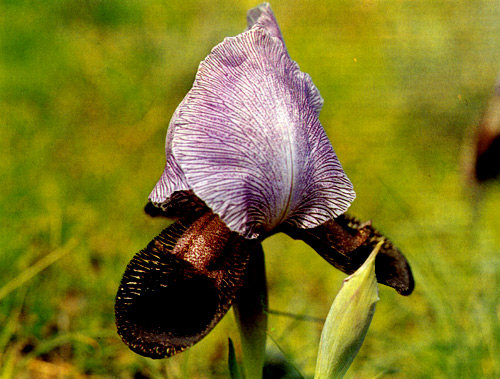
12. A natural hybrid, I. iberica×I. camillae
Wild forms of this iris mostly grow in steppe and semi-desert zones of Asia and Europe. The I. foetidissima species, native to the Mediterranean coast of Europe and North Africa, is characterized by its evergreen foliage and large coral-red round - shaped seeds. For more detailed description of its biological and decorative characters see the section "Spuria Iris". The subgenus Crossiris includes eleven species, easily distinguished by a fringed edge on the central rib of the falls. Wild iris of this subgenus are met in subtropical zones in Japan, China and North America. They can grow in the north only in greenhouses or as indoor plants, its two species, I. wattii and I. japonica, have been cultivated for many years in the Black Sea coastal areas of the Caucasus. I. japonica, an evergreen perennial with thick beautiful foliage and delicate light-blue flowers, proves excellent for soil surface fixation on slopes.
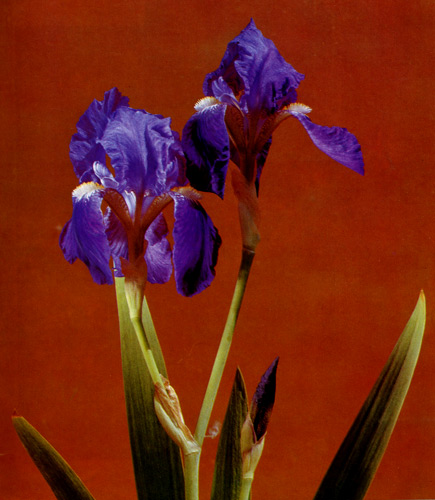
13. Iris germanica
The subgenus Iris includes Iris germanica, a type species of the genus; hence, according to the rules of botanical nomenclature, the genus name must be repeated in its subgenus name. This subgenus is the most complex from the viewpoint of botany and the most interesting from a flower-grower's point of view. They are best distinguished by a so-called "beard", a dense hairy strip on the central rib of their falls and standards. This subgenus is the most recent in the evolutionary aspect. The majority of its species have attained a perfect adaptation to insect pollination.

14. A natural hybrid, I. paradoxa×I. camillae
According to the latest classification of the subgenus Iris worked out by D. Taylor (1976), an American botanist, the sub-genus species are divided into six sections: Iris, Oncocyclus, Regelia, Hexapogon, Psammiris and Pseudoregelia. The former three are described in more detail in the section "Naturally Occurring Iris Species of the USSR".
The section Iris comprises species popularly known in floricultural literature as "bearded" iris. The name is derived from the former name of the section "pogon", which means "beard" in Greek.
The section Oncocyclus is most numerous as far as the number of species is concerned. Their wild forms grow in the Caucasus, North Iran, Asia Minor, and I. ewbankiana extends as far as south-western regions of Central Asia.
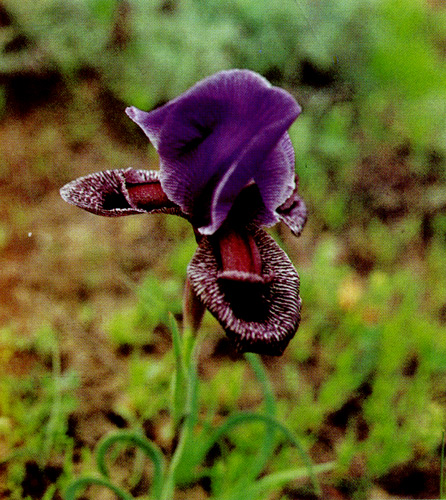
15. A natural hybrid, I. iberica×I. paradoxa
The subsection species are characterized by scape-like flower stems bearing one bloom and by the absence of clearly expressed roots on the rhizomes. All species of the section present particular interest for their decorative merits and are worthy of being cultivated and used in hybridization.
The section Regelia comprises seven species which grow in the mountains of Central Asia and Afghanistan. The rhizomes of these iris consist of short and thin segments alternating with long thin off-shoots, i. e. stolons. Scape-like flower stems bear two blooms (sometimes in cultivated plants a third one may develop). The majority of the section species are of great interest for cultivation and hybridization purposes.
The section Hexapogon is represented by only two species: I. falcifolia and I. longiscapa, both wild flowers of Central Asian deserts.
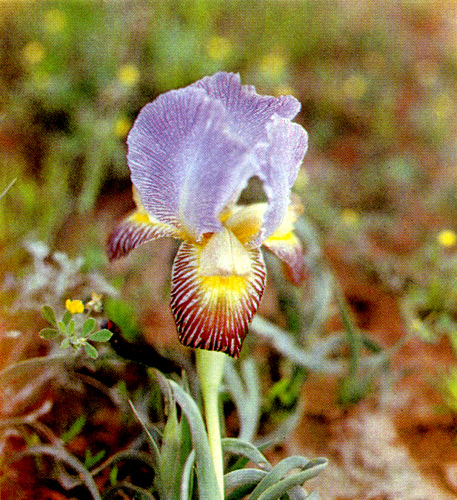
16. Iris camillae
The section Psammiris owes its name to the Greek word "psammiris", which means sandy or loving sand. Three iris species belong to this section, i. e. I. bloudowii, I. flavissima and I. potaninii. These short-stalked dwarf iris may be used in hybridization to make dwarf bearded iris hardier, which is typical of I. flavissima plants of Siberian origin, superb in rock gardens.
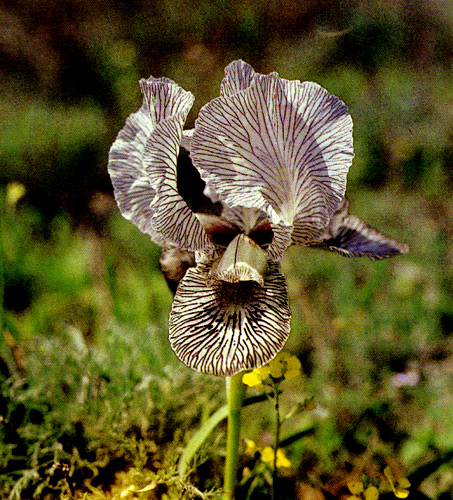
17. A natural hybrid, I. iberica×I.camillae
The section Pseudoregelia species occur in desert and mountainous zones of Central Asia, the Himalaya and Mongolia. It is represented only by two species in the USSR: I. tigridia, found in the Altai mountains and Lake Baikal area, and I. mandschurica — in the Primorye Territory. The former is notable for its spotted petals, which is rare with iris and may be used in breeding work.
|
ПОИСК:
|
© FLOWERLIB.RU 2001–2022
При использовании материалов активная ссылка обязательна:
http://flowerlib.ru/ 'Библиотека по цветоводству'
При использовании материалов активная ссылка обязательна:
http://flowerlib.ru/ 'Библиотека по цветоводству'